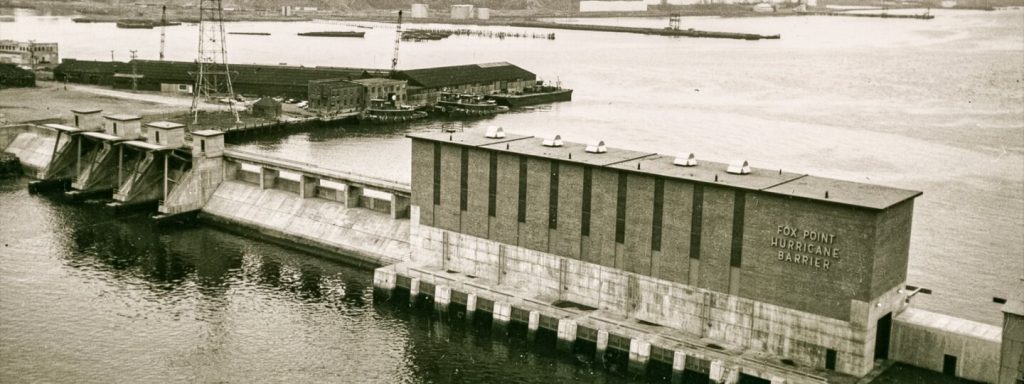The Fox Point Hurricane Barrier following completion in March 1966 (Providence, Rhode Island). Credit: New England Division of the U.S. Army Corps of Engineers (Waltham, Massachusetts)
More than ten years have passed since Hurricane Sandy exposed New York City to devastating coastal flooding. Several cost-effective flood megaprojects, including levees and storm surge barriers, have been presented to the NY-NJ region to prevent future billion-dollar disasters, but none have moved forward. Researchers studying climate adaptation have put forward theories about why so few cities have built cost-effective flood protection megaprojects, but a recent study by Princeton University and Rutgers University analyzes real-world cases to uncover actionable insights.
The study, published in the Journal of Water Resources Planning and Management, thoroughly reviews two U.S. Army Corps of Engineers flood megaprojects in Rhode Island that emerged simultaneously after an active period of hurricane activity around the 1950s. After extensive archival research, the researchers pieced together a detailed explanation for why one project advanced to completion while the other did not.
Their findings suggest that the storm surge barriers are politically challenging because of modern environmental laws that encourage oppositional views to legally challenge projects. They also find that the general public tend to favor alternative options that are more aesthetically pleasing, cheaper, and faster to implement, even if they do not offer the same level of protection. To address these limitations, the authors provide suggestions for how the U.S. Army Corps of Engineers might improve their planning process.
“Storm surge protection design hasn’t changed much over the past half century,” said D.J. Rasmussen, the lead author who completed this research while a doctoral student and postdoc at Princeton’s School of Public and International Affairs. “Many designs are unpopular with the public and environmental NGOs because they are an eyesore and can disrupt the natural environment. The efficiency of deploying coastal adaptation could be improved using designs that are more popular,” Rasmussen said.
Revised plans for the Narragansett Bay Barriers, April 1964. Credit: US Army Engineer Division, New England / US National Archives and Record Administration, Waltham, MA.)
Flood protection megaprojects—like levees and storm surge barriers—that can protect densely populated areas often fail to be built, even when technical analyses of the plans show that they are cost-effective solutions. Delving into the circumstances surrounding the two Rhode Island projects, the researchers conclude that a primary factor for whether projects succeed is political and public support.
Rhode Island had experienced a number of costly storms and flooding events from 1938 to the 1950s, killing hundreds of Rhode Islanders and causing more than $100 billion in damages (in 2017-normalized U.S. dollars). With these storms fresh in the public’s memory, the Fox Point Hurricane Barrier to protect the city of Providence received nearly unanimous support at public hearings and from local business leaders, and it moved forward quickly following Hurricane Carol in 1954. From this example, the researchers conclude that strong public support encourages the backing of elected officials, which is critical for moving massive infrastructure projects successfully though Congress.
On the other hand, the Narragansett Bay Hurricane Barriers, although proposed in the same period following Hurricane Carol, received less support from the start. In a region heavily reliant on fishing and coastal tourism, communities had more concerns related to the effects of the proposed barriers on maritime navigation, water quality, fish and wildlife, and recreation activities. However, the US Army Corps of Engineers failed to give much attention to these factors, focusing on the engineering and flood prevention aspects of the project and providing no discussion of alternative strategies. The Army Corps of Engineers appeared to disregard public opinion outright, angering community members. As more time passed, public opinion further soured making the project politically unfeasible.
Artist rendering of a proposed storm surge barrier at the entrance to New York Harbor. Credit: US Army Corps of Engineers, reprinted from USACE 2019b
“Drawing stakeholders into the process of planning coastal defense from the get-go and exploring the costs and benefits of concrete infrastructure alongside other options, ranging from natural defenses to retreat, would make the entire process go more smoothly and reach a sensible decision point sooner,” said co-author Michael Oppenheimer, a professor at Princeton University and director of the Center for Policy Research on Energy and the Environment there.
These cases show how decision-making for these megaprojects involves coordination and cooperation among the public, all levels of government, and organized interests, such as businesses and NGOs. The researchers recommend several ways for the US Army Corps of Engineers’ planning process to better incorporate this political reality. These include ensuring the support of the public and elected officials before getting too far into the planning of a project to determine whether there is sufficient commitment to move forward and promoting more innovative designs that incorporate green or nature-based approaches.
“Trying to ram things down the public’s collective throat—as has been the case too often in the past and still is the way some governments would prefer to work today—generates delay more often than progress,” Oppenheimer said.
The researchers also suggest that the US Army Corps of Engineers should undertake studies of the effectiveness and reliability of such alternatives to improve their own confidence in how these would compare to more traditional coastal flood reduction infrastructure.
More information: D. J. Rasmussen et al, Coastal Defense Megaprojects in an Era of Sea-Level Rise: Politically Feasible Strategies or Army Corps Fantasies?, Journal of Water Resources Planning and Management (2022). DOI: 10.1061/(ASCE)WR.1943-5452.0001613
Provided by Princeton University
Citation: Two coastal flood defense projects provide lessons for making future infrastructure projects more successful (2023, February 16) retrieved 18 February 2023 from https://phys.org/news/2023-02-coastal-defense-lessons-future-infrastructure.html
This document is subject to copyright. Apart from any fair dealing for the purpose of private study or research, no part may be reproduced without the written permission. The content is provided for information purposes only.

